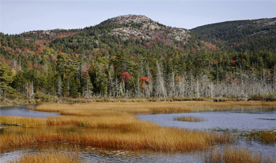
Brian Olsen Studies Superstorm Sandy’s Effects on Tidal Marshes to Target Restoration Efforts, Assist Threatened Species
The Federal Emergency Management Agency is monitoring infrastructure repair efforts around Atlantic City, New Jersey, where Superstorm Sandy killed 73 and caused billions of dollars in damage when it barreled ashore a little more than two years ago.
In January, Brian Olsen, assistant professor of biology and ecology, will start gauging the restoration of tidal marshes and birds along the same stretch of coastline impacted by the most deadly and destructive storm of the 2012 Atlantic hurricane season.
The U.S. Fish and Wildlife Service — which works with other agencies to conserve migratory birds for the public good — awarded Olsen a $1.4 million grant to conduct a 22-month study on the recovery of birds associated with tidal marshes from Virginia to Maine.
The area is home to 56 percent of the world’s salt marsh specialist vertebrates, including a number of at-risk migratory birds, he says.
“A thorough understanding of Hurricane Sandy’s effects on tidal marsh wildlife is needed to help direct remediation funds where they will have the greatest impact,” Olsen wrote in the project overview.
For the study, he’ll utilize four years of data — the two immediately prior to Hurricane Sandy and the two immediately following it.
The data, he says, will provide an unprecedented opportunity to document the superstorm’s short-term impacts on tidal marshes — including reproduction and survival rates of threatened species.
“By noting which marshes within the storm’s path were most impacted, we will be able to identify what makes a marsh resilient to change,” says Olsen.
“We hope that information will help us to increase the resiliency of the region’s marshes to future challenges.”
The data also will inform long-term impact projections of future storms on the resilience of willets, clapper rails, Nelson’s sparrows, seaside sparrows and saltmarsh sparrows. Olsen and his colleagues will integrate the estimates into population viability analyses to benefit conservation planning and restoration efforts.
The universities of Delaware, Connecticut and New Hampshire are participating, as is the State University of New York, Syracuse.
In November, Olsen began participating in a University of Connecticut-led, two-year $820,000 study on the effectiveness of Hurricane Sandy restoration projects on tidal marshes and their wildlife. The goal is for direct conservation actions to be applied where they’ll most benefit increased resilience of green infrastructure.
“We view the tidal marshes of the Northeast U.S. as a sort of shadow infrastructure for the nation. They are the water filters and storm buffers and fish hatcheries for every major coastal city from Portland [Maine] to Boston to D.C.,” Olsen says
“Since the 1600s, however, New York and New Jersey alone have lost thousands of acres of this green infrastructure … at precisely the same time that our need for the marshes increased. If only a fraction of that lost habitat had been maintained, the impacts of Hurricane Sandy on traditional human infrastructure would have been much different. We’re trying to reverse the trend.”
One task will include incorporating models for sea-level rise and storms into a modeling framework. This — in combination with other predicted effects of climate change, urban growth and conservation of tidal wetlands and adjacent uplands — will guide adaptive decision-making and management.
“The health of wildlife populations gives us a glimpse into the health of our green infrastructure,” says Olsen, who also is an assistant professor with UMaine’s Climate Change Institute.
“If we can understand what makes these marshes resilient to disturbances, we can understand how to preserve their benefits to society as economically as possible.”
Part of Olsen’s portion of the study includes monitoring restoration and control sites in Connecticut and northward during the 2015–16 field seasons. The University of Delaware and State University of New York are also participating.
Contact: Beth Staples, 207.581.3777
